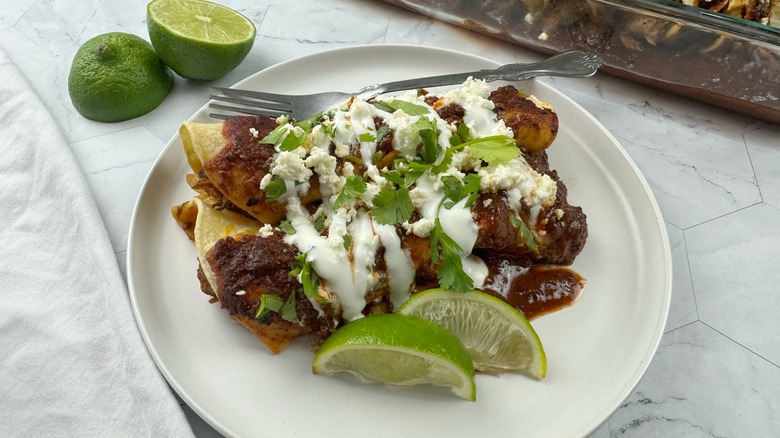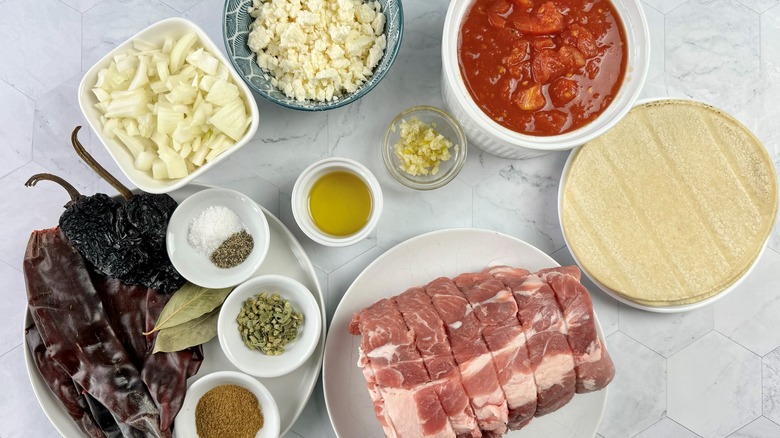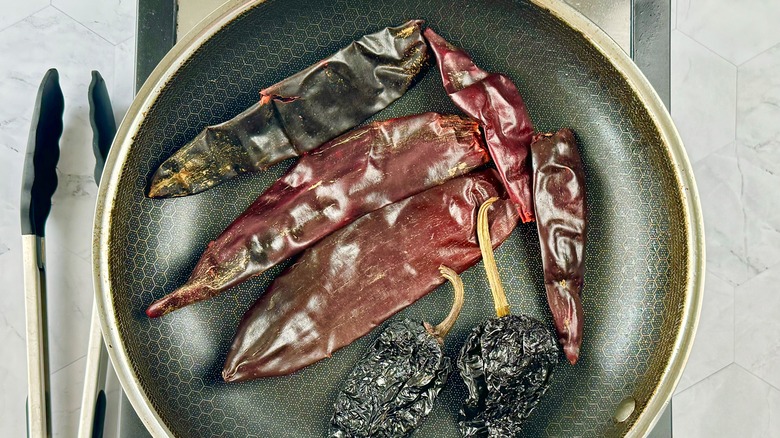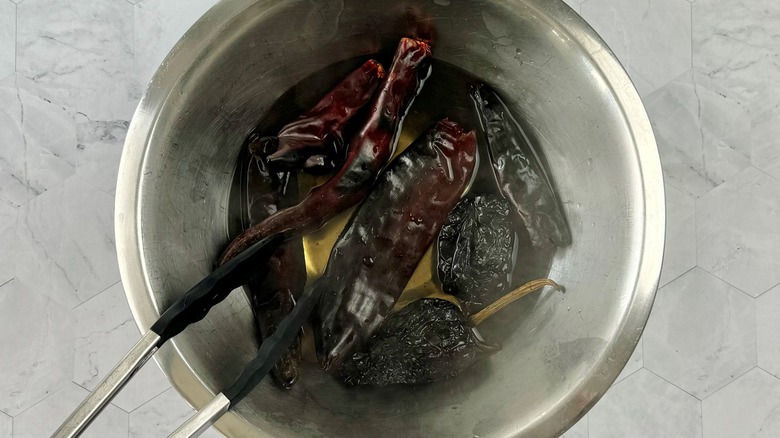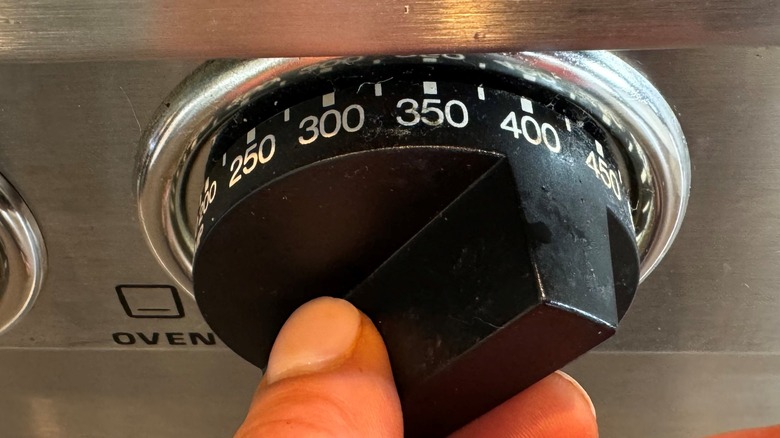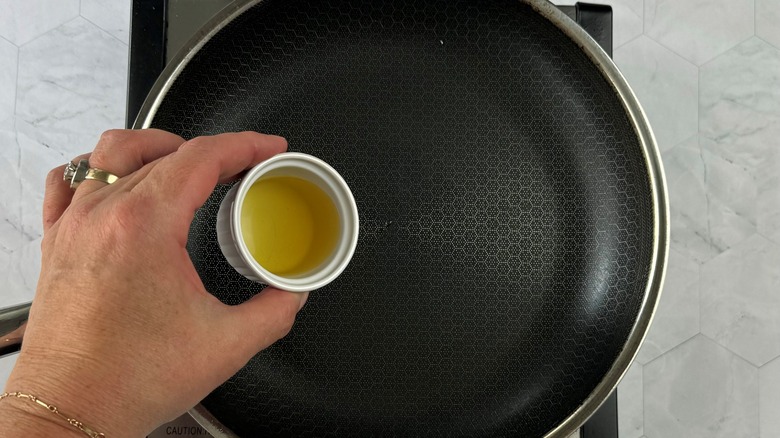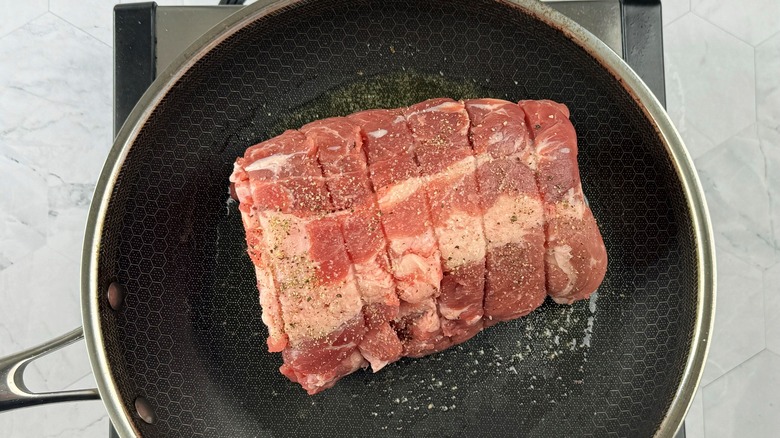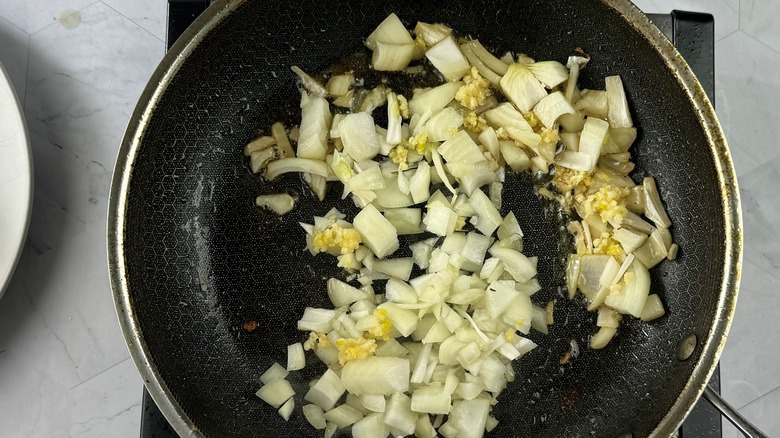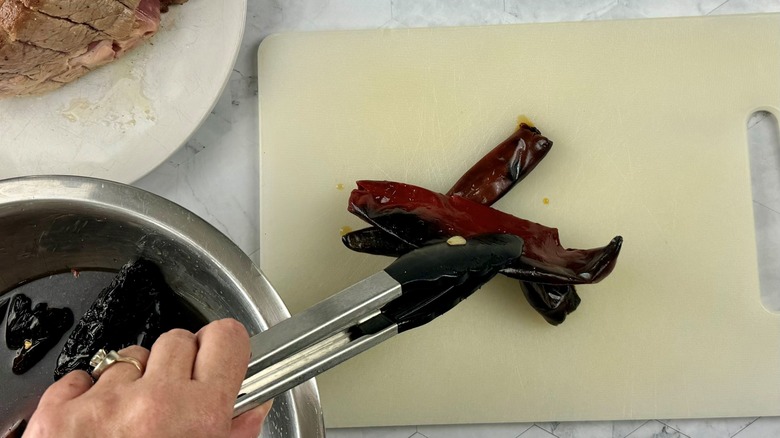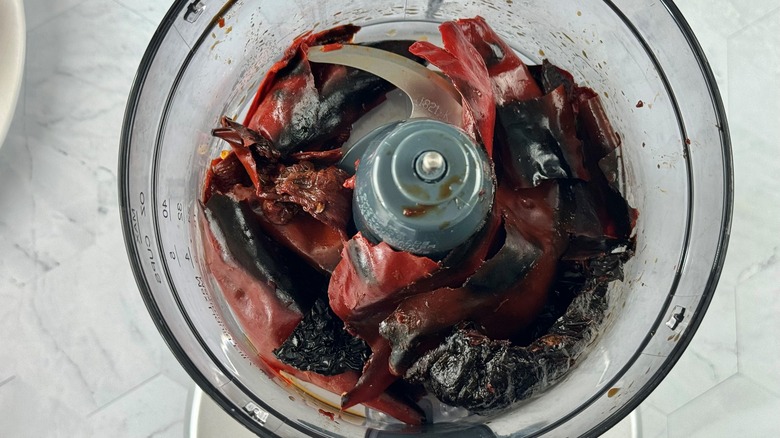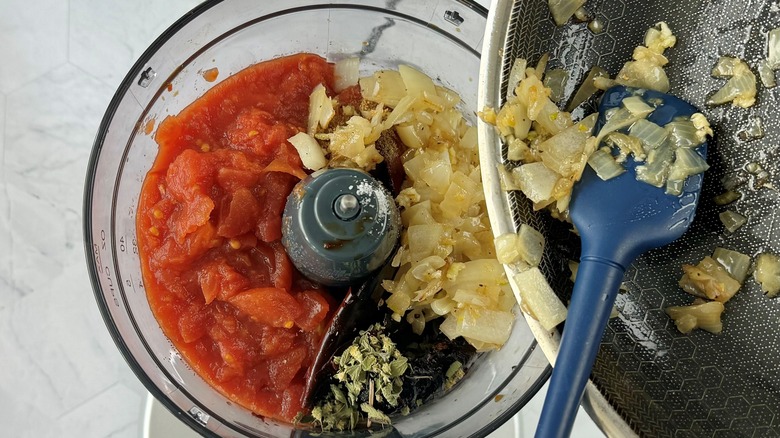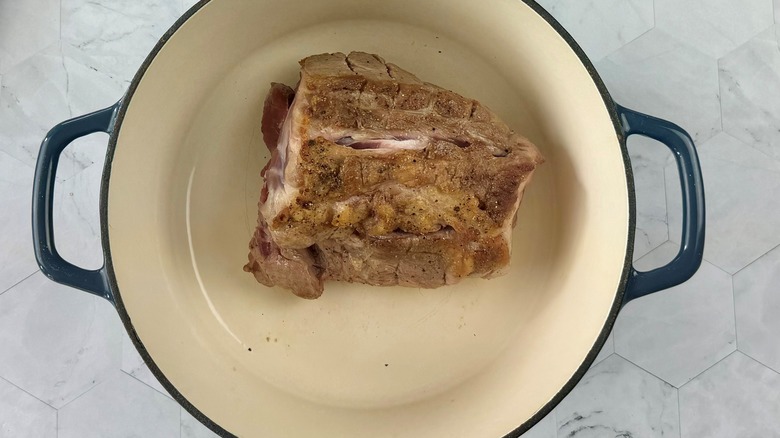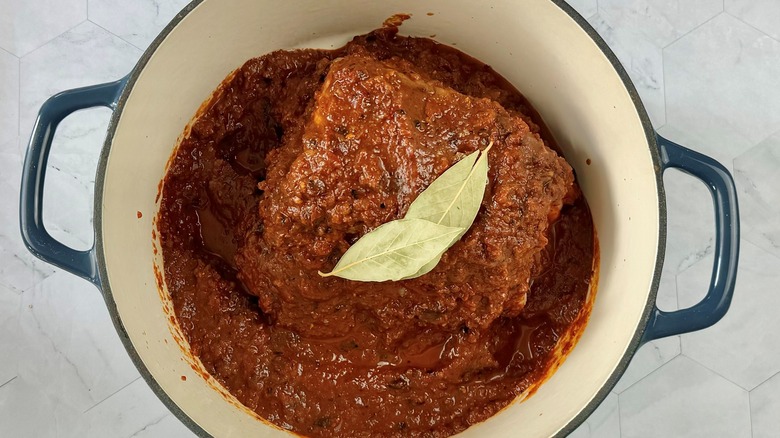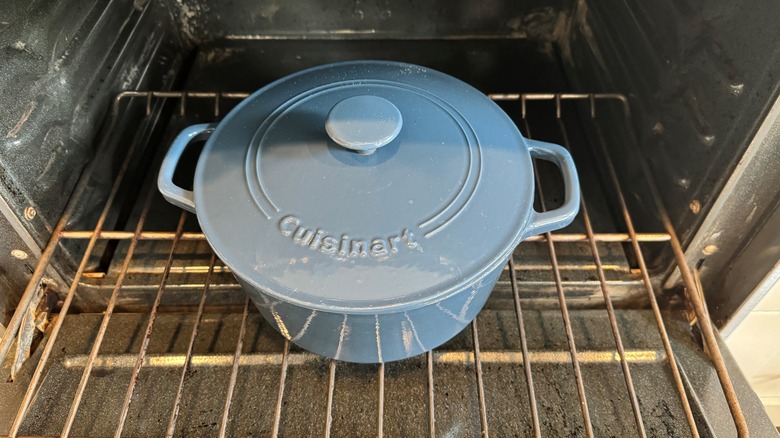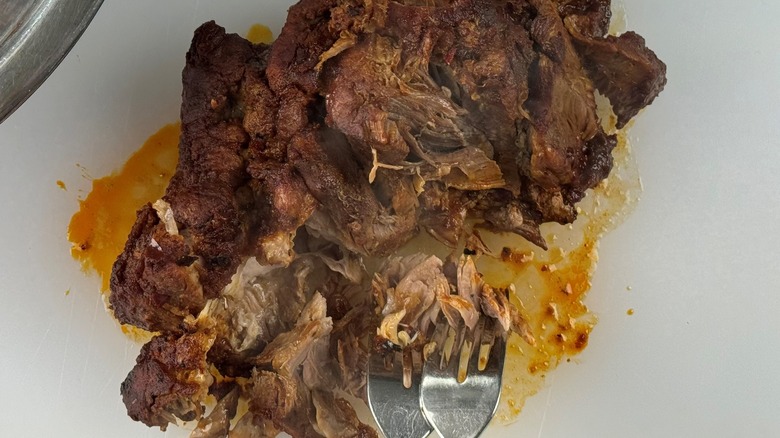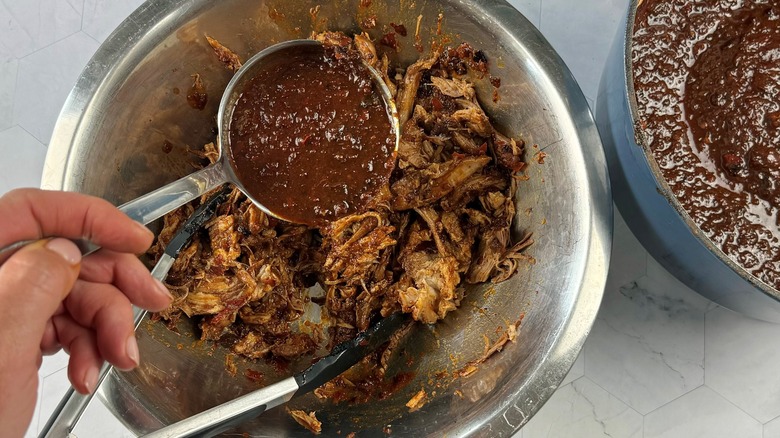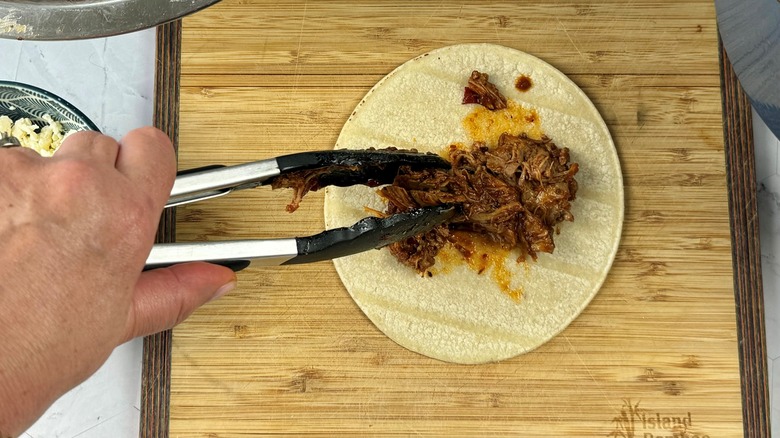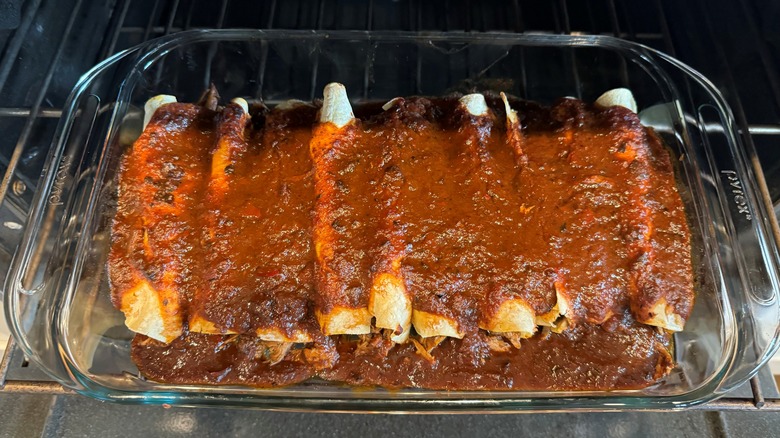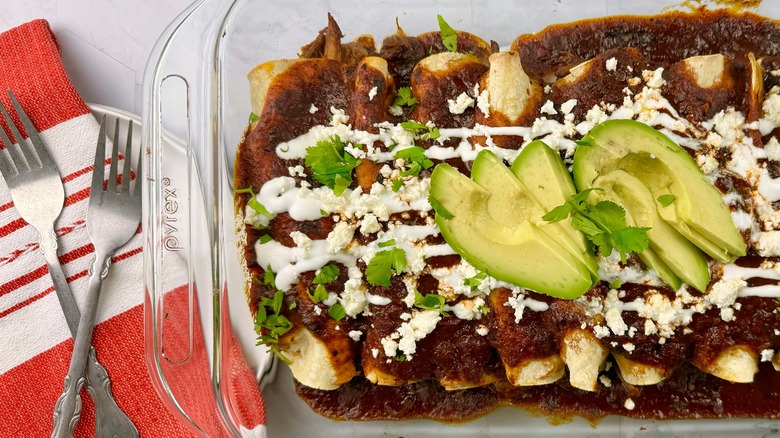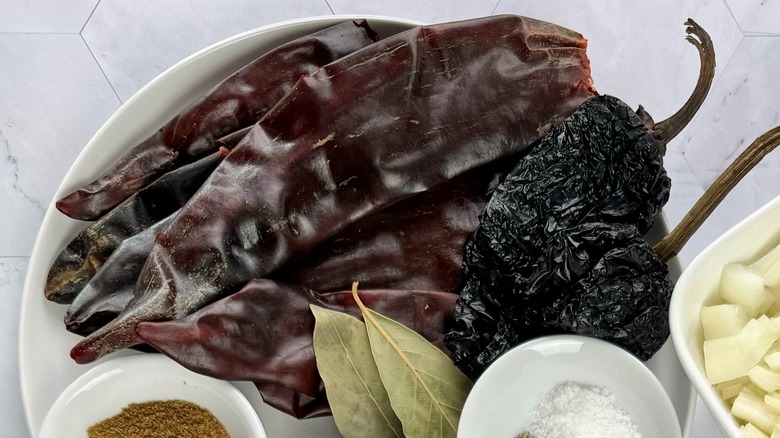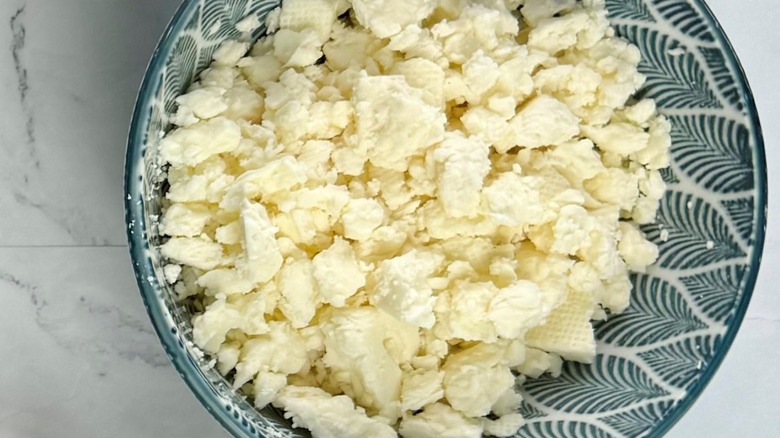Pork Enchiladas Rojas Recipe
While many an enchilada recipe starts with canned enchilada sauce, developer Julianne De Witt prefers to make her own roja sauce. This sauce is red in color, as the name implies, with the hue coming from tomatoes and some mild red chiles. Instead of going with chicken or beef enchiladas, De Witt is using pork shoulder. "It's an inexpensive cut that works well in low-and-slow cooking applications like braising and stewing," she says. It's also easy to shred once cooked. DeWitt makes her enchiladas with corn tortillas, as is typical, but allows that flour ones can be used, if you prefer. (Thinking of making homemade tortillas? Here are some tips to help you get it right.)
De Witt describes this dish as "a hearty meal that's so satisfying and worth the time it takes to make" and suggests that the only sides it needs are rice and beans or a green salad. The leftovers will keep for up to four days in the refrigerator — if you want to reheat one or two at a time, the microwave is fine, but you could also reheat an entire pan in an oven set to 300 F.
Collect the ingredients for the pork enchiladas rojas
The roja sauce for this recipe is made with dried guajillo and ancho peppers, salt, pepper, onion, garlic, canned diced tomatoes, oregano, and cumin. You'll also need avocado oil, pork shoulder, and bay leaves for the filling, corn tortillas for wrapping, and cotija cheese for topping the enchiladas.
Step 1: Toast the peppers
Toast the guajillo and ancho chiles in a saute pan over medium-high heat, approximately 30 seconds per side.
Step 2: Soak the peppers
Add the chilies to a medium-sized bowl. Pour enough boiling water over the chiles to cover them. Allow the chiles to soften for 10 minutes.
Step 3: Turn on the oven
Preheat the oven to 350 F.
Step 4: Heat a frying pan
Place a saute pan over medium-high heat, then add the oil.
Step 5: Brown the pork
When the pan is hot, add the pork, season liberally with salt and pepper on both sides, and sear until browned, 2 minutes per side.
Step 6: Take the pork out of the pan
Remove from the pan and set aside.
Step 7: Fry the aromatics
Add the onion and garlic to the saute pan. Cook for 1 minute.
Step 8: De-seed the peppers
Remove the chiles from the water. Remove the stems, slice in half, and scrape out the seeds.
Step 9: Combine the chiles, tomatoes, and spices
Add the chiles, tomatoes, oregano, 1 teaspoon salt, and ½ teaspoon pepper to a food processor.
Step 10: Puree the roja sauce
Add the onions and garlic, and pulse until smooth.
Step 11: Put the pork in a pot
Add the pork to a Dutch oven.
Step 12: Add the roja sauce and bay leaves
Pour the chili sauce over the pork, then add the bay leaves.
Step 13: Bake the pork
Place the pork in the oven and cook for 2 ½ hours.
Step 14: Shred the pork
Remove the pork from the Dutch oven and place on a cutting board. Using 2 forks, shred the pork, then add it to a large bowl.
Step 15: Mix some sauce with the pork
Add a ladle of sauce to the pork and mix. If the sauce is too thick, add a little water to bring it to the desired consistency.
Step 16: Fill the enchiladas
Lay the tortillas on a flat surface. Add pork to the center of the tortillas and sprinkle with cotija cheese.
Step 17: Roll the enchiladas
Roll to close, add to a 9x11-inch baking pan, and top with the remaining sauce
Step 18: Cook the enchiladas
Bake the enchiladas at 350 F for 10 minutes, until bubbling.
Step 19: Top the enchiladas
Remove from the oven and top with avocado, sour cream, cilantro, and more cotija, if desired.
Pork Enchiladas Rojas Recipe
Filled with a homemade roja sauce and tender, slow-cooked pork shoulder, these enchiladas boast plenty of spicy, smoky, meaty flavor.
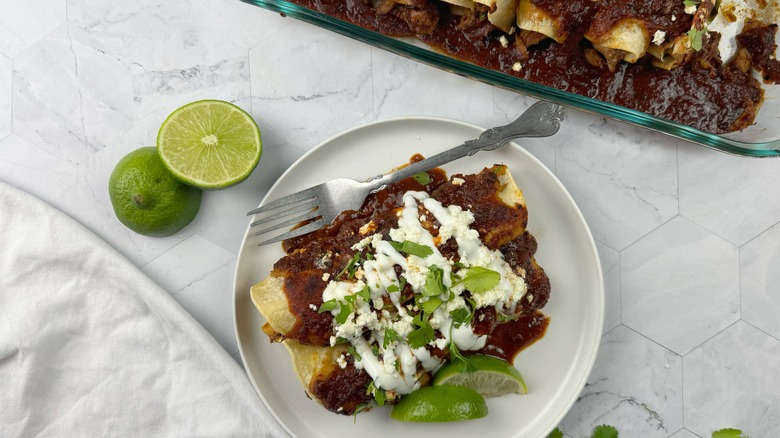
Ingredients
- 5 dried guajillo chile peppers
- 2 dried ancho chile peppers
- Boiling water
- 2 tablespoons avocado oil
- 1 ½ pounds pork shoulder
- 1 teaspoon sea salt, plus more to taste
- ½ teaspoon fresh ground black pepper, plus more to taste
- 1 yellow onion, diced
- 4 cloves garlic, crushed
- 1 (28-ounce) can diced tomatoes
- 2 teaspoons Mexican oregano
- 2 teaspoons cumin
- 2 bay leaves
- 10 (6-inch) white corn tortillas
- 1 cup crumbled cotija cheese, plus more for garnish
Optional Ingredients
- Sliced avocado
- Lime wedges
- Sour cream
- Minced cilantro
Directions
- Toast the guajillo and ancho chiles in a saute pan over medium-high heat, approximately 30 seconds per side.
- Add the chilies to a medium-sized bowl. Pour enough boiling water over the chiles to cover them. Allow the chiles to soften for 10 minutes.
- Preheat the oven to 350 F.
- Place a saute pan over medium-high heat, then add the oil.
- When the pan is hot, add the pork, season liberally with salt and pepper on both sides, and sear until browned, 2 minutes per side.
- Remove from the pan and set aside.
- Add the onion and garlic to the saute pan. Cook for 1 minute.
- Remove the chiles from the water. Remove the stems, slice in half, and scrape out the seeds.
- Add the chiles, tomatoes, oregano, 1 teaspoon salt, and ½ teaspoon pepper to a food processor.
- Add the onions and garlic, and pulse until smooth.
- Add the pork to a Dutch oven.
- Pour the chili sauce over the pork, then add the bay leaves.
- Place the pork in the oven and cook for 2 ½ hours.
- Remove the pork from the Dutch oven and place on a cutting board. Using 2 forks, shred the pork, then add it to a large bowl.
- Add a ladle of sauce to the pork and mix. If the sauce is too thick, add a little water to bring it to the desired consistency.
- Lay the tortillas on a flat surface. Add pork to the center of the tortillas and sprinkle with cotija cheese.
- Roll to close, add to a 9x11-inch baking pan, and top with the remaining sauce.
- Bake the enchiladas at 350 F for 10 minutes, until bubbling.
- Remove from the oven and top with avocado, sour cream, cilantro, and more cotija, if desired.
Nutrition
| Calories per Serving | 604 |
| Total Fat | 38.5 g |
| Saturated Fat | 13.5 g |
| Trans Fat | 0.0 g |
| Cholesterol | 120.6 mg |
| Total Carbohydrates | 32.4 g |
| Dietary Fiber | 7.5 g |
| Total Sugars | 5.4 g |
| Sodium | 823.4 mg |
| Protein | 33.0 g |
What other chile peppers can I use in enchiladas?
De Witt uses guajillo and ancho chiles in this recipe, both of which are on the mild side. Guajillos have between 2,500 and 5,000 Scoville units, which is a heat level comparable to that of milder jalapeños, although the latter can range up to 8,000 Scovilles. Anchos, however, only have 1,000–2,000 Scovilles. If you want an even milder sauce, you could go with all anchos or even swap out the peppers for dried Anaheims, which are only half as hot.
Of course, you might want to make a spicier sauce, in which case you can mix in some dried chiles de arbol, which have 15,000 to 30,000 Scoville units, or else stir in some cayenne pepper or crushed red pepper. De Witt says you could also add non-dried chiles to the mix, stirring in some chopped jalapeños or canned chipotles en adobo. The former, if fresh, would give the sauce a little green vegetable flavor, while the latter would lend some smoky notes.
What is cotija cheese, and what does it taste like?
Cotija cheese is a Mexican cheese that can be made of cow's or goat's milk and has a semi-moist, crumbly texture. The flavor is slightly salty but not too strong, and De Witt says she likes to use it in this recipe "because it adds some tang without taking away from the flavors of the roja sauce."
If you don't have any cotija, there are a few different cheeses that could be used in its place. Feta cheese is a good substitute because it has a similar texture and mild flavor, while Parmesan and Romano could also work. De Witt also notes that if you want more of a cheesy, restaurant-style enchilada, you could also grate some cheddar or pepper Jack and sprinkle it over the top once the enchiladas are done cooking. A few minutes under the broiler (or even in the still-warm oven) should make the cheese nice and melty.
